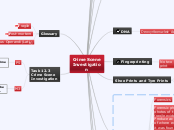Crime Scene Investigation
Forensic science
Scientific tests or techniques used in connection with the detection of crime.
The application of science to the law.
Police Responsibities at the Crime Scene
Preserving Life
Preventing Evidence and Crime Scene Contamination
Detaining Suspects and Witnesses
Controlling the Scene
Examining the Crime Scene
Crime Scene Investigation
Searching for and examining physical traces which may have been left behind at a crime scene
These physical traces are used to try to make a connection between someone suspected of commiting a crime, the scene of the crime and the victim.
Physical evidence left behind at a crime scene
Body fluids
Hairs
Textile fibres from clothing
Materials used in buildings such as pain and glass
Footwear and shoes prints
Tool and tyre marks
Flammable substances used to start fires
Drugs
Drink (and driving)
Poisonings
Firearms
Explosives
Document authenticity
DNA
Deoxyribonucleic Acid
The genetic material contained in the cells of all living things
Unique to an individual
Blood, hair and other deposits of the human body found at a crime scene all contain DNA
DNA is often collected from people who are arrested and kept on a national database
Fingerprinting
No two people have the same print
Shoe Prints and Tyre Prints
Can help prove a person or vehicle visited the scene of a crime
Shoeprints can also indicate a persons height and weight
Role of CSI
Forensics
Forensic photograhers takes full set of photos of the scene of a crime to preserve fragile evidence
Produce accurate written records and diagrams of where evidence was located and the position it was found
Maintain Evidence Database
Maintain and update systems with details of recovered evidence
May need to interview victims of crime
Attend court to give evidence
Sometimes required to attend post-mortems
Provide scientific analysis of evidence
Linking Crime Scenes
Software can be used to pick out similarities and differences between different crime scenes from the evidence database
Gives the possibility to learn more more about the criminal who committed the crimes
Crime Scenes may be linked by
Location
The time at which the crime takes place
The type of crime
How the crime was committed
How stolen articles have been disposed of
Many other ways that crimes can be linked allows the patterns of the offender to build a profile
Offender Profiling
Different types of offender can be linked with different types of crime
The aim of profiling is to:-
Build a profile of an offender so that they can be found, identified and charged
Understand the motivation of an offender committing a crime. This information can be used to stop others offending
Glossary
Fragile
Post-mortem
Modus Operandi (Latin)
Task 12.3 Crime Scene Investigation
P5
Describe the role of the Crime Scene Investigation Unit.
To achieve P5, learners are required to describe the role of crime scene investigation. There are a number of real-life and dramatised TV programmes that learners can watch (The Real CSI, FBI Files, CSI, CSI Miami, CSI New York, NCIS) that will assist them with this task. They could also set up their own crime scene or invite a guest speaker.
M3
Explain how crime scenes can be linked and offenders profiled.
For M3, learners can then develop this knowledge to enable them to explain how crime scenes are linked and offenders are profiled. There are also TV programmes looking at this aspect of crime scene investigation that can help learners see how these links are made.
